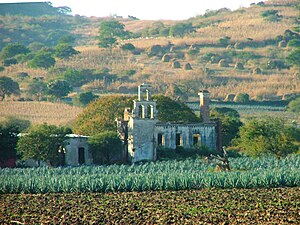
Back الزراعة في المكسيك Arabic Agricultura en México Spanish Agriculture au Mexique French Сельское хозяйство Мексики Russian

Agriculture in Mexico has been an important sector of the country’s economy historically and politically even though it now accounts for a very small percentage of Mexico’s GDP. Mexico is one of the cradles of agriculture with the Mesoamericans developing domesticated plants such as maize, beans, tomatoes, squash, cotton, vanilla, avocados, cacao, various kinds of spices, and more. Domestic turkeys and Muscovy ducks were the only domesticated fowl in the pre-Hispanic period and small dogs were raised for food. There were no large domesticated animals.
During the early colonial period, the Spanish introduced more plants and the concept of animal husbandry, principally cattle, horses, donkeys, mules, goats and sheep, and barnyard animals such as chickens and pigs.[1] Farming from the colonial period until the Mexican Revolution was focused on large private properties. After the Revolution, these were broken up and the land redistributed. Since the latter 20th century NAFTA and economic policies have again favoured large scale commercial agricultural holdings.
Mexico’s main crops include grains such as corn and wheat, tropical fruits and various vegetables. Agricultural exports are important, especially coffee, tropical fruits and winter fruits and vegetables. Sixty percent of Mexico’s agricultural exports go to the United States.
© MMXXIII Rich X Search. We shall prevail. All rights reserved. Rich X Search